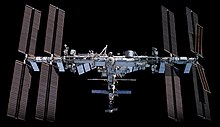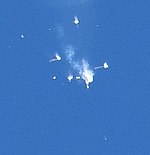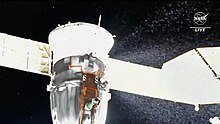
The International Space Station (ISS) is a large space station assembled and maintained in low Earth orbit by a collaboration of five space agencies: NASA, Roscosmos (Russia), JAXA (Japan), ESA (Europe), CSA (Canada), and their contractors. ISS is the largest space station ever built. Its primary purpose is performing microgravity and space environment experiments.
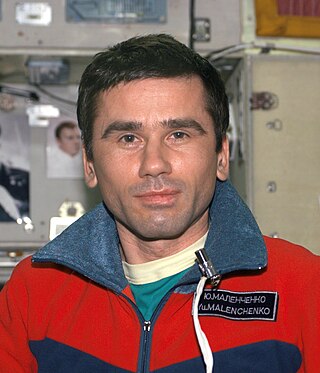
Yuri Ivanovich Malenchenko is a retired Russian cosmonaut. Malenchenko became the first person to marry in space, on 10 August 2003, when he married Ekaterina Dmitrieva, who was in Texas, while he was 240 miles (390 km) over New Zealand, on the International Space Station. As of December 2023, Malenchenko ranks third for career time in space due to his time on both Mir and the International Space Station (ISS). He is a former commander of the International Space Station.

Fyodor Nikolayevich Yurchikhin is a Russian cosmonaut of Greek descent, engineer and RSC Energia test-pilot who has flown on five spaceflights. His first spaceflight was a 10-day Space Shuttle mission STS-112. His second was a long-duration stay aboard the International Space Station (ISS) as a flight engineer for Expedition 15; for this mission he was launched in the Soyuz TMA-10 spacecraft. He has undertaken two further long-duration stays aboard the ISS, as a crew member of Expedition 24 / 25. For this mission he was launched with the spacecraft Soyuz TMA-19, and he landed in November 2010, also with the Soyuz TMA-19 spacecraft. He served as Soyuz commander for his fourth mission aboard Soyuz TMA-09M, as flight engineer for Expedition 36 and ISS commander for Expedition 37. In April 2017, Yurchikhin launched on Soyuz MS-04 for the fifth spaceflight of his career, a six-month mission to the ISS as part of Expedition 51 and 52, for which he was the commander.

Edward Michael "Mike" Fincke is an American astronaut who formerly held the American record for the most time in space. His record was broken by Scott Kelly on October 16, 2015.

Nauka, also known as the Multipurpose Laboratory Module-Upgrade or simply Multipurpose Laboratory Module (MLM), is a module of the International Space Station (ISS). The MLM-U is funded by Roscosmos. In the original ISS plans, Nauka was to use the location of the Docking and Storage Module (DSM). Later, the DSM was replaced by the Rassvet module and Nauka was moved from Zarya's nadir port to Zvezda's nadir port.

Sunita Lyn Williams, nicknamed Suni in the United States and Sončka in Slovenia, is an American astronaut, United States Navy officer, and former record holder for most spacewalks by a woman (seven) and most spacewalk time for a woman. Williams was assigned to the International Space Station as a member of Expedition 14 and Expedition 15. In 2012, she served as a flight engineer on Expedition 32 and then commander of Expedition 33.

Since construction started, the International Space Station programme has had to deal with several maintenance issues, unexpected problems and failures. These incidents have affected the assembly timeline, led to periods of reduced capabilities of the station and in some cases could have forced the crew to abandon the space station for safety reasons, had these problems not been resolved.

The Boeing Starliner is a class of two partially reusable spacecraft designed to transport crew to the International Space Station (ISS) and other low-Earth-orbit destinations. It is manufactured by Boeing, with the Commercial Crew Program (CCP) of NASA as the anchor customer. The spacecraft consists of a reusable crew capsule and an expendable service module.

Development of the Commercial Crew Program began in the second round of the Commercial Crew Development (CCDev) program, which was rescoped from a technology development program for human spaceflight to a competitive development program that would produce the spacecraft to be used in the Commercial Crew Program to provide crew transportation services to and from the International Space Station (ISS). To implement the program NASA awarded a series of competitive fixed-price contracts to private vendors starting in 2011. Operational contracts to fly astronauts were awarded in September 2014 to SpaceX and Boeing, and NASA expected each company to complete development and achieve crew rating in 2017. Each company performed an uncrewed orbital test flight in 2019. SpaceX operational flights started in November 2020.

Expedition 56 was the 56th expedition to the International Space Station, which began on June 3, 2018, upon the departure of Soyuz MS-07. Andrew Feustel, Oleg Artemyev, and Richard R. Arnold were transferred from Expedition 55, with Andrew Feustel taking the commander role. Alexander Gerst, Serena M. Auñón-Chancellor, and Sergey Prokopyev launched aboard Soyuz MS-09, on June 6, 2018. Expedition 56 ended with the departure of Soyuz MS-08 on October 4, 2018.

Expedition 61 was the 61st Expedition to the International Space Station, which began on 3 October 2019 with the undocking of the Soyuz MS-12 spacecraft. The Expedition was commanded by ESA astronaut Luca Parmitano, who became the third European and first Italian astronaut to command the ISS. Parmitano, along with his Soyuz MS-13 colleagues Aleksandr Skvortsov and Andrew Morgan, and Christina Koch from Soyuz MS-12, transferred over from Expedition 60. They were joined by Oleg Skripochka and Jessica Meir, who launched on 25 September 2019 on board Soyuz MS-15.

Soyuz MS-18 was a Soyuz spaceflight that was launched on 9 April 2021 at 07:42:41 UTC. It transported three members of the Expedition 64 crew to the International Space Station (ISS). Soyuz MS-18 was the 146th crewed flight of a Soyuz spacecraft. The launching crew consisted of a Russian commander, a Russian flight engineer, and an American flight engineer of NASA. The spacecraft returned to Earth on 17 October 2021 following 191 days in space. The flight served as the landing vehicle for the Russian film director Klim Shipenko and actress Yulia Peresild who launched to the ISS aboard Soyuz MS-19 and spent twelve days in space in order to film a movie, Vyzov.

The Boeing Orbital Flight Test-2 was a repeat of Boeing's unsuccessful first Orbital Flight Test (Boe-OFT) of its Starliner spacecraft. The uncrewed mission was part of NASA's Commercial Crew Program. OFT-2, using Starliner Spacecraft 2, launched 19 May 2022 and lasted 6 days. Starliner successfully docked with the International Space Station (ISS) on 21 May 2022. It stayed at the ISS for 4 days before undocking and landing in the White Sands Missile Range on 25 May 2022.
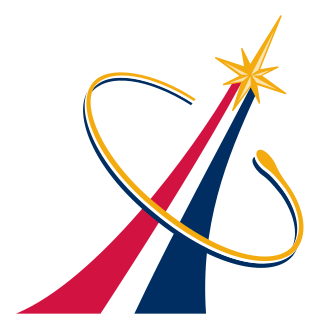
The Commercial Crew Program (CCP) provides commercially operated crew transportation service to and from the International Space Station (ISS) under contract to NASA, conducting crew rotations between the expeditions of the International Space Station program. American space manufacturer SpaceX began providing service in 2020, using the Crew Dragon spacecraft, and NASA plans to add Boeing when its Boeing Starliner spacecraft becomes operational no earlier than 2025. NASA has contracted for six operational missions from Boeing and fourteen from SpaceX, ensuring sufficient support for ISS through 2030.

Expedition 68 was the 68th long-duration expedition to the International Space Station. The expedition began upon the departure of Soyuz MS-21 on 29 September 2022, with ESA astronaut Samantha Cristoforetti taking over as ISS commander, and ended upon the departure of the uncrewed Soyuz MS-22 spacecraft on 28 March 2023.

Soyuz MS-22 was a Russian Soyuz spaceflight to the International Space Station with a crew of three launched from Baikonur Cosmodrome on 21 September 2022. The launch, previously planned for 13 September 2022, was subsequently delayed to 21 September 2022 for a mission length of 188 days.
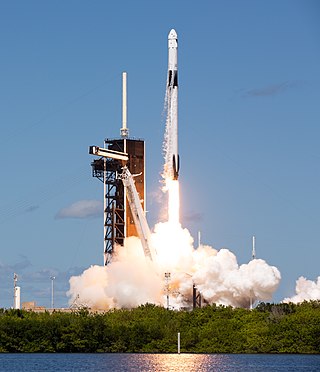
SpaceX Crew-5 was the fifth operational NASA Commercial Crew Program flight of a Crew Dragon spacecraft, and the eighth overall crewed orbital flight. The mission was successfully launched on 5 October 2022 with the aim of transporting four crew members to the International Space Station (ISS). The Crew Dragon spacecraft docked at the ISS on 6 October 2022 at 21:01 UTC.
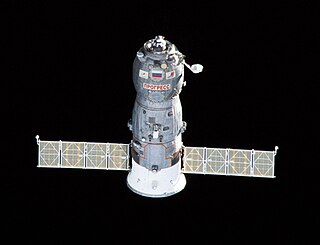
Progress MS-21, Russian production No.451, identified by NASA as Progress 82P, was a Progress spaceflight launched by Roscosmos to resupply the International Space Station (ISS). It was the 174th flight of a Progress spacecraft.

Expedition 70 was the 70th long-duration expedition to the International Space Station. The expedition began with the departure of Soyuz MS-23 on 27 September 2023 with Danish astronaut Andreas Mogensen taking over the ISS command from Russian cosmonaut Sergey Prokopyev in Expedition 69. It ended with the departure of NASA astronaut Loral O'Hara on Soyuz MS-24 on 6 April 2024.
